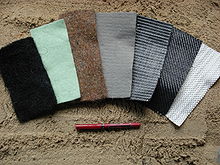Geotextile
Geotextiles are flat or three-dimensional textiles that are usually water-permeable. They are used as building materials in civil engineering , waterways and traffic route engineering and are an important aid for geotechnical safety work. Aquatextiles are a technical modification of geotextiles and are used to clean rainwater in road construction.
Geotextiles are made of either natural (such as reeds , jute and coconut ) fibers or artificial (such as polypropylene , polyamide , polyester and polyethylene ) materials and for separating, Dränen ( drain acting ), filtering, reinforcement, protection, packaging and erosion protection used. They are used in the form of woven fabrics , nonwovens and composites. Due to their limited durability, geotextiles made of jute or coconut fibers are only used if they later rot .
Classification
Geotextiles can be divided into three types with regard to their structure:
- Fabrics are geotextiles that consist of yarns or threads that intersect regularly, usually at right angles. They are used when high tensile strengths are required. They are also suitable as filters for static loads.
- Nonwovens are created through the consolidation of fibers that are laid on top of one another. Depending on the consolidation process (needling, gluing or fusing), the geotextile is given different expansion properties. Nonwovens are mainly used for separating, filtering and protecting.
- Composites are woven fabrics, nonwovens and other materials that are connected over a large area. In this way, properties of different geotextiles can be combined.
use cases
Geotextiles are essentially suitable for the following applications:
- Erosion control
- Protect
- Filter
- Reinforce
- Drains
- Separate
- Clean
features
The starting point for the development of geotextiles was hydraulic engineering and the construction of roads on soils with poor load-bearing capacity, sometimes with high water content , in the early 1970s . In order to improve the stability of the subsurface, a textile fleece is applied in this case and then covered with bulk material. In this way, the service life and resilience of the traffic area is increased. In addition to being used in road and path construction, geotextiles are also suitable for construction tasks in railway construction.
In addition to their use in traffic route construction, geotextiles are also used in earthworks and hydraulic engineering. For example, they serve as building materials for securing dams and landfills or can be used in the field of engineering biology. There, with the help of natural geotextiles made of jute, reed or coconut, soil erosion and landslides on embankments, ditches and water banks can be avoided. They also support reforestation , the expansion of watercourses and the renaturation of lignite - opencast mines and landfills .
Geotextiles can have a beneficial effect on plant growth as they protect against drying out and direct sunlight.
Special applications
- Soil stabilization with the help of geotextiles is known as “ reinforced earth ”. In addition to geotextiles, other geosynthetics such as geogrids and riding arena fabrics as well as wire mesh are also suitable .
- Geo-composite textiles with ( capillary ) cavities can be used for wall drainage in buildings.
- Composite textiles with cavities for ventilation can divert radon and methane gas escaping from the ground .
- When an absorbent non-woven fabric is applied to the surface of fresh concrete , it absorbs water from the surface layer of the concrete and thereby reduces the local water-cement ratio , which increases the strength and tightness of the layer near the surface.
- Three-dimensionally woven, sewn or welded geotextile with honeycomb chambers to hold sand or soil material is also marketed as a geocell. Similar to lawn grids , it is used to secure slopes and embankments as well as soft soils that are to be walked on or driven on. It can also be used instead of gabions to quickly create walls or earthen walls.
- Aquatextiles primarily remove hydrocarbons from rainwater in pavement pavements. The degradation rate meets the requirements for light oil separators according to DIN EN 858-1 + A1: 2004 [EN 585] with a residual oil content of <5 ml / l.
Norms and standards
- Germany
- Leaflet for the use of geotextiles and geogrids in earthworks in road construction
- Technical delivery conditions for geosynthetics in earthworks in road construction (TL Geok E-StB 05)
- DIN EN 15381 - Geotextiles and geotextile-related products - Properties that are required for use in the construction of road surfaces and asphalt layers
- DIN EN 15382 - Geotextiles - Geosynthetic sealing membranes - Properties that are required for use in traffic structures
- Austria
- RVS 08.97.03 Geotextiles in the substructure
- ÖNORM S 2076/2 landfills - geotextile protective layers
- Switzerland
- SN 670240 - Geotextiles and geotextile-related products; Terms and product description
Individual evidence
- ↑ Fabia Denninger (Ed.): Lexicon of technical textiles . Deutscher Fachverlag, Frankfurt am Main 2009, ISBN 978-3-86641-093-0 , p. 152.
- ↑ Wolfgang R. Roth roof: Handbook of engineering geology and geotechnical engineering . Springer Verlag, Heidelberg 2002, ISBN 3-540-41353-7 , pp. 369 .
- ^ E. Heinemann, R. Feldhaus, R. Paul: Hydraulics for civil engineers . Vieweg + Teubner Verlag, Wiesbaden 2003, ISBN 3-519-15082-4 , pp. 212 f .
- ↑ Georg Heerten: Geotextiles in hydraulic engineering . Announcements from the Franzius Institute for Hydraulic Engineering and Coastal Engineering at the University of Hanover, 1981, ISSN 0340-0077 , p. 261 .
- ↑ Frank Heimbecher, Melanie Strutz: "TenCate GeoClean" with regard to the binding and degradation of hydrocarbons in oil counter undermined runoff waters and soils . Greven 2019, p. 16 .






